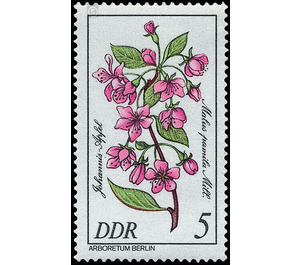Rare woody plants - Germany / German Democratic Republic 1981 - 5 Pfennig
Theme: Flora
| Country | Germany / German Democratic Republic |
| Issue Date | 1981 |
| Face Value | 5.00 |
| Color | multi-colored |
| Perforation | K 14 |
| Printing Type | Rotogravure 2 |
| Stamp Type | Postage stamp |
| Item Type | Stamp |
| Chronological Issue Number | 2315 |
| Chronological Chapter | GER-DDR |
| SID | 32306 |
| In 19 Wishlists | |
Rare Woods With the illustrations of rare woody plants from the Arboretum Berlin, the Ministry of Posts and Telecommunications of the German Democratic Republic publishes six multicolored special postage stamps. Special Stamps from January 13 to March 12, 1981 Rare Woody Plants Plant life on earth is most impressively represented by woody plants, especially in the form of trees, shrubs and lianas. It is therefore understandable that woody plants are highly valued in the design of our environment, especially of cities and municipalities, but also of metropolitan areas and recreational areas as decorative and climatic improving elements. This high esteem is further enhanced by new scientific knowledge of the course of a closely interwoven earth and biographical process of development of our woody flora in Central Europe lasting for many millions of years. We are aware of such knowledge that the Central European woody flora is relatively poor compared to other woody floras of the Northern Hemisphere. Natural events, such. For example, the tertiary unfolding of the Alps and the Quaternary Ice Age, in conjunction with climatic changes, have created new environmental conditions for the evolutionary development of the woody flora, destroying many strands of woodland still native to Central Europe at the end of the Tertiary. Today in Central Europe only 236 woody species (they belong to 84 genera and 38 families) are of course common. In this process of deprivation man is also an important factor. During the Ice Age, but especially after the last glaciation burst, humans have gradually used and changed the territory to their current state. Our natural flora, including the woody species, is roommate of this territory. Their clans have found their niches in the conditions of man's influence on the environment, which correspond to their possibilities. In this process, natural selection has been more or less completely replaced by artificial selection. The further development of the woody flora needs our special attention and care. The responsibility of humans has grown tremendously. For centuries, foreign woody plants have been introduced and cultivated. Most of them are relatives of their settled in Tertiary Central Europe woody pines. Even though they are rare, they have found a place with us again and convincingly demonstrate the manifold possibilities in the design of our environment. In the development of further possibilities on the meaningful use of mostly long-lived plants profound knowledge about the living conditions of every kind or cultural form and not least love for them and respect for their lives are required. They are among the prerequisites for a proper and informed fulfillment of our tasks, as outlined by the "Law on the planned organization of the socialist culture of the GDR" (1970). 5 Pfennig value: Johannis apple The kind of the kind Malus (Rosaceae) is very rich in forms. The Johannis or paradise apple in the narrower sense may be shrubby to tree-shaped. The spherical pseudopods are on average about two inches thick. Of particular beauty are the relatively large flowers whose appearance essentially emanates from the light pink Kronblöttern. In Central Europe, the plant is scattered. She is from her homeland, the Middle East, the southern Soviet Union u. a. naturalized and wild. From this species, which has been in culture for ages, and by crossing with other species many of today's apple varieties have emerged.


